BLOOD PASSOVER
(PASQUE DI SANGUE)By ARIEL TOAFF
CHAPTER TEN
Contents
- BLOOD, LEPROSY AND CHILD MURDER IN THE HAGGADAH
- "Memorial of blood" becomes the basis of the ritual of Pesach
- Hate as a basis for "religious" beliefs
- Why Ashkenazi Judaism should have chosen precisely this legend, out of so many?
- "Pour out your wrath against the peoples who do not recognize you"
- Turning the blood accusation around and blaming the victims to be the perpetrators
- The circumcision of Jesus
p. 154]
BLOOD, LEPROSY AND CHILD MURDER IN THE HAGGADAH
Over the course of the first two evenings of Pesach, during the ritual dinner of the Seder, all persons at the table read the Haggadah, a liturgical text containing the account of the exodus of the people of Israel from Egypt based on the Biblical narration and rabbinical materials, together with the benedictions concerning the foods symbolic of the Jewish Passover, among them the unleavened bread (mazzot), charoset, bitter herb (maror ), and lamb's foot. The text of the Haggadah is often ornamented by miniatures, tables and woodcuts illustrating the salient stages of the history of the Jews in the land of the Pharaohs, as well as to the events linked to their miraculous salvation and the perilous journey undertaken towards the Promised Land.
The illustrations were not selected by accident; in addition to reflecting the artistic tastes of the Jews of various epochs and localities, the illustrations were intended to stress and focus upon particular historical or legendary events and underlying messages made indirectly perceptible through these images, while updating their content. [1]
Very rarely do the illustrations distance themselves from the text of the Haggadah and refer to legends of the Midrash presenting a few similarities with the Passover. One of these passages, which is anomalous insofar as it concerns the matter under discussion, but was surprisingly widespread despite its difficult and delicate nature, is the passage describing the Pharaoh, stricken with leprosy and cured by the blood of Jewish boys, cruelly killed for that very purpose.
The Midrash Rabbah in fact reports that the Pharaoh was punished with leprosy by God, and that his physicians advised him to cure himself by means of health-giving baths in the blood of Jewish children.
One hundred and fifty children of the nation of Israel are said to have been killed every day, from morning till night, to supply the Egyptian despot with the precious medicament. Cries of pain and desperation of the children of Israel, as well as of their fathers and mothers, bereaved of their tender offspring, are said to have risen to high heaven, accompanied by prayers for redeeming vengeance. [2]
p. 154]
"Memorial of blood" becomes the basis of the ritual of Pesach
The anonymous Sefer Ha-Yashar, an ethical text composed in the 13th century, illustrated the tragic legend with a plethora of detail, extending the dimensions of the massacre and transforming it into authentic history.
"When God smote the Pharaoh with the illness, the latter turned to his magicians and wise men so that they might cure him. The latter, so that he might be cured, prescribed that the sores be covered with the blood of children. At this point, the Pharaoh, heeding their counsel, sent his functionaries to the land of Goshen so that they might abduct Jewish children. The order was carried out, and the infants were taken by force from their mother's laps to be presented to the Pharaoh every day, one by one, it was then that his physicians killed them and, with their blood, bathed the sores on his body, repeating the operation for days at a time, so that the number of butchered children reached the number of three hundred seventy five". [3]
The grisly legend of the massacre of the Jewish children sacrificed to restore health to the monarch of Egypt, while it remained almost ignored by Iberian, Italian and Oriental Judaism, met with predictable success and a warm reception among Jews of the Franco-German territories and the Ashkenazi communities of northern Italy. As early as the 11th century, the famous French exegetist Rashi (R. Shelemoh Izchaki) of Troyes reminded his readers that the Pharaoh "contracted leprosy and (to get well) killed the children of Israel to take baths in their blood". [4]
This account was followed by later, other well-known rabbis and commentators, such as Yehudah Loeb of Prague and Mordekhai Jaffe of Cracow. The topos [traditional theme or motif] was definitively established and was to enjoy a long life in Hebrew and Yiddish. [5]
Finally, and this is hardly surprising, the legend of the Pharaoh bathing in Jewish blood became very closed linked to the ritual of Pesach.
The texts of Medieval Ashkenazi Judaism therefore hastened to place this innocent blood in precise relationship with the tradition of mixing the red wine into the dough of the charoset, the fruit preserve eaten during the Seder dinner as a "memorial of blood". [6]
Hate as a basis for "religious" beliefs
Izchak ben Moshe, 13th century Austrian ritualist, explicitly stated that "The precept to drink wine of a red color (during the Seder dinner) is in remembrance of the leprosy said to have struck the Pharaoh, to cure himself of which he immolated suckling infants (of the Jews) and moreover in remembrance of the blood of the Passover lamb and the blood of circumcision. [7]
p. 155]
After the blood of the circumcision, the Passover lamb, the sacrifice of Isaac, the sacrifice of martyrs for the faith, the pure and innocent blood of Jewish children sacrificed to the therapeutic requirements of the enemies of Israel, an open path, safe and promising, led to the ritual celebrations of the Seder of the Jewish Passover. But to enable the topos to become even more deeply rooted, in all its mysterious and disturbing aspects, in the popular mind, conveying messages which were in fact alternative messages, accompanied by polemics of burning contemporary interest, the legend needed to be cemented in place through the crude force of images, fantastic and unreal in outward appearance only. These were the origins of the woodcuts of the Jewish victims of perverse infanticide in the illustrations of the Haggadah. [8]
The first testimonies to this iconographic topic are handed down to us in five Hebrew manuscripts, all originating in Bavaria and the centers of the Rhineland (Nuremberg in particular) and may be chronologically situated in the second half of the 15th century, i.e., the period of the most widespread dissemination of ritual murder accusations in the German-speaking lands. The miniatures are of crude workmanship, restricted to reproducing, often only suggesting, the essential elements of the tale, which was presumed to be well known to the reader. [9]
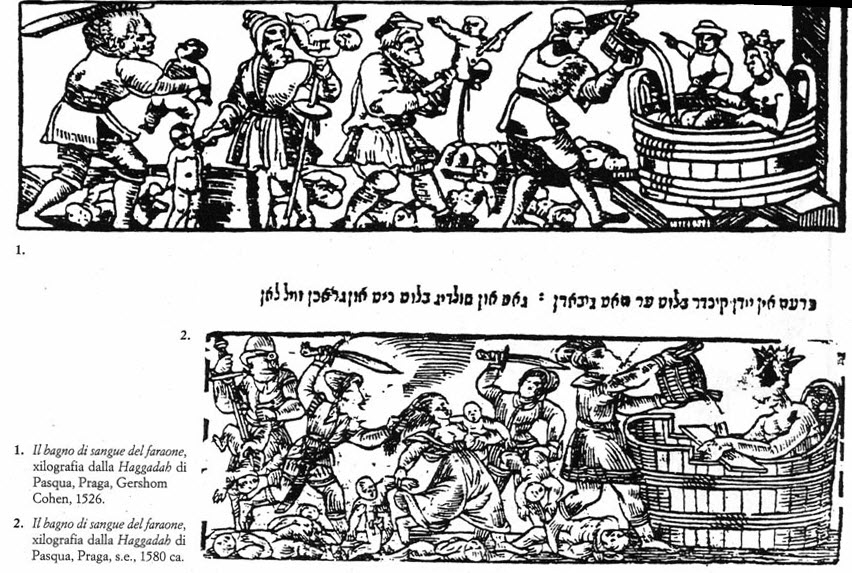
A rather more detailed and revealing example of the iconography of the leprous Pharaoh appears in the most famous and oldest Haggadot with printed illustrations: that of Prague in 1526 (there is a second edition with important variants, dating back to the end of the century), of Mantua in 1560 (republished in 1568) and Venice in 1609. [10]
In the Haggadah of Prague, the image is used to illustrate that section of the text which describes the sufferings and laments of the children of Israel forced to perform forced labor in Egypt. The woodcut depicts a scene of amazing crudity. [11]
On the right the crowned Pharaoh, curled up in a large tub of wood with staves, is enjoying a bath of fresh blood, poured in by an obliging domestic servant by means of a suitable recipient. On the left and in the center of the panel, some armed thugs, monstrous and cruel, dressed as soldiers and German peasants, are shown massacring innocent children, decapitating them, quartering them, and skewering them like thrushes on pikes and swords. Other children await their tragic fate with resignation. The points of the lances emerge from the open gash of the circumcision wound, while dismembered little bodies litter the ground.
p. 156]
In the so-called "second Haggadah" of Prague, the scene is repeated with some redundant and lachrymose added touches. In the center of the picture, a desperate mother, with her breasts exposed, attempts hopelessly to flee, carrying her unhappy infants with her. [12]
The butchery of the preceding edition is further confirmed with an abundance of detail. I believe there can be little doubt that this image is modeled after the Massacre of the Innocents during King Herod’s reign in Palestine (Matthew 2:16), as depicted in a woodcut of the Ultraquist Passional, published in Prague in 1495. The latter was a Bohemian adaptation of the Passional Sanctorum of Jacopo de Voragine (1230-1298), while the scene in question is very similar, in terms of both crudity of detail and persons depicted (with the natural exception of the Pharaoh engaged in these cruel ablutions), to that in the Haggadah, published in that same Bohemian city decades later. [13]
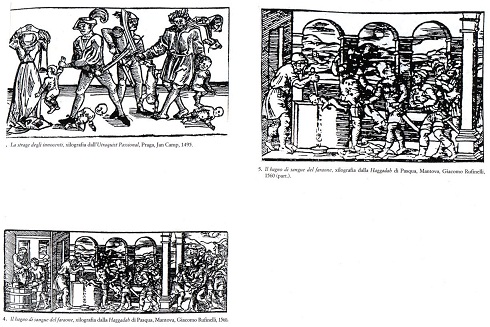
In the Haggadah of Mantua (1560 and 1568), the image of the Pharaoh's bath is not so crude and is better organized; in some ways, it is rather more interesting and instructive. [14]
The woodcut is divided into three sections; the scene takes place in a sumptuous palace, illuminated by large windows and divided by portals and columns.
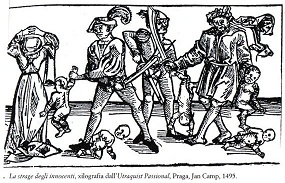
In the right-hand panel, some soldiers and functionaries are taking babes in arms away from anguished mothers, while, in the left-hand panel, the Pharaoh is seen taking his bath of blood in a wooden tub, assisted by two servants.
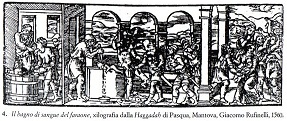
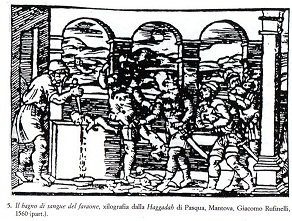
The central section of the scene, the most detailed, depict the hall of the palace, resembling a place of worship. Here, the children are shown being brought in by solders, and delivered to a personage responsible for butchering the victims. These persons butcher them with a knife, placed on an altar standing at the end of the room, causing the blood to gush forth in streams, collected in a suitably prepared vessel. [15]
The analogies with the classical iconography relating to ritual murder are surprisingly precise here, and certainly intentional.
The scene of the bath of blood appears with a few major differences in the Haggadah of Venice published in 1609. [16] On the left, armed soldiers take children by force from the Jewish mothers, while on the right, a crowned Pharaoh with his pock-marked body, emerges erect from his wooden bathtub. This time, the butchers cut the throats of the children in such a way that the blood flows directly onto the diseased body of the Egyptian monarch, without bothering to collect it in vases or recipients kept ready for the purpose. The important novelty in this scene consists of the fact that the pitiless assassins are shown dressed like Turks, their heads covered with typical turbans. The artist, presumably working at Venice, where the Haggadah was printed, obviously considered it preferable, out of justifiable prudence, to associate the authors of this savage crime with Islam and the Koran of Mahomet, with the soldiers of the Great Turk and the unpopular Ottoman Empire, rather than depict them as good Christians subjects of the Serenissima.
p. 157]
Why Ashkenazi Judaism should have chosen precisely this legend, out of so many?
But the message of these images is substantially identical, and provides an answer to the question of why Ashkenazi Judaism should have chosen precisely this legend, out of so many in the Midrash, as its very own, linking it by force to the rites of the Passover. It is certainly true that the account presupposes the same ambiguous attraction to the mysterious and fascinating curative powers of blood, and children’s blood in particular, as did surrounding Christian German society. This attraction and fascination often developed into a true and veritable obsession.
Those writers attempting to stress the love-hate relationship (or, more cautiously, a hostility-intimacy relationship) linking Jews and Christians in this context are therefore correct. We refer to those writers who lived side by side in the Alpine valleys and along the river banks furrowing the regions in which German was the mother tongue and the Jews spoke Yiddish. [17]
But that is not all. These images were intended to provide a response, of irrefutable historical obviousness and vivid suggestiveness, to the ritual murder accusation linked with the celebration of the rituals of the Pesach. The accusation was therefore turned on its head, or generally subordinated to the crime of child murder for ritual or curative purposes, which was then demoted in the scale of seriousness, as an aberration of which the enemies of the Jews (including the Christians) were also guilty.
Circumcised children of Israel had also been sacrificed by superior order so that their blood might be drained from their bodies in their hour of martyrdom and thus be capable of ensuring Redemption.
"Pour out your wrath against the peoples who do not recognize you"
One intention of analogous indication emerges in all its obviousness from the illustration accompanying the aggressive invocation against nations refusing to accept the God of Israel (Shefoch, "Pour out your wrath against the peoples who do not recognize you..."), a characteristic liturgical formula, with openly anti-Christian meanings, recited after the Passover meal, which we shall dwell upon further along.
In this case, the scene contained in the Haggadah of Venice of 1609 [18] depicts a group of necromancers, dressed as Moors, with their typical oriental turbans, surrounded by crowds of demoniacal, dancing Negroes, while magicians and enchanters attempt to raise the dead on the other hand. The caption, written in rhyme, is significant, and revelatory of the underlying message: "Consumed be the ignorant kingdoms, which serve demons and believe in necromancy". [19]
p. 158]
Now, the accusation made against the Jews of practicing magic and necromancy, often confused with the practical Cabbalah and assimilated to it, was public knowledge, as was the close relationship, often uncritically presupposed, between necromancy, ritual murder and the magical uses of blood. Even Pope Pius V Ghisleri, when he decided to expel the Jews from the Pontifical State by the bull Hebraeorum gens in 1569, making an exception for those of Rome, Ancona and Avignon, accused them of practicing divinatory and magical rites with pernicious and diabolical consequences for Christians. [20]
Turning the blood accusation around and blaming the victims to be the perpetrators
The illustration accompanying the invective against the nations who refused to accept the God of Israel, the Goyim, was intended to turn the accusation around: it was not the Jews who were the necromancers and magicians, the spell-weaving charlatans of prodigious potions, the seductive soothsayers and macabre exorcists, but also, and above all, the other nations and peoples who did not accept the God of the Israelites.
In any case, Jews were not the only people who practiced vain and dangerous sciences of this kind; on the contrary, the Jews were in authoritatively good company, together with the Moslems and Christians.
Once again, the iconography of the Haggadah implied the emergence, from the narrative and liturgical texts, of every possible debating point useful in analyzing the message of the Pesach, prudently camouflaged within a historical framework. Its readers must have understood this.
Another tragedy inflicted upon the children of Israel emerges from the Biblical text of Exodus. The cruel order of the Pharaoh to drown all new-born Jewish males in the Nile so that their people might not multiply (Ex. 1:22) promptly found easily recognizable equivalents in the iconography of the Haggadah. In the edition of Prague of 1526, the scene is depicted on a bridge with turreted piers and typically German and medieval architecture, like many bridges on the Rhine, the Rhône and the Danube. Here, a few peasants are depicted flinging defenseless infants into a few the waters below, while a mother, also on the bridge, is depicted as seized with desperation. [21]
The broad panel depicting this episode from the Haggadah of 1560, shows infants being thrown from the bridge into the waters of the river while a few mothers rush down onto the exposed gravel riverbed in a hopeless attempt to reach the bank and save their children from the rapids, while others give way to despair, raising their arms to Heaven. [22]
p. 159]
The Haggadah of Venice of 1609 contained two interesting illustrations of this episode. The first scene depicts the inside of a Jewish home, in which the husband and wife sleep in separate beds to avoid sexual relations, precursor of tragedy: the birth of a son might, in fact, lead to his inevitable killing by the Egyptians. In confirmation of their justifiable concern, the merest glimpse of an exterior scene is depicted, showing a few figures on the river bank, while the waters sweep away the bodies of drowned infants. [23]
In the second scene, which takes place in the presence of the Pharaoh, seated on the throne, a few servants on the river bank throw poor nursing infants into the river, torn from their mother's bosom, while the heads of the miserable drowned babes are seen protruding from the raging waters. [24]
The reminder of the problematical relationship between waterways and human sacrifice and the many victims of mysterious child-killings revealed by the ebb and flow of the rivers, propelling the bodies of the victims onto the banks, and the miracles performed by the holy martyrs of ritual murder, [alleged to be] capable of floating upriver, against the current, in a stupendous manner and returning miraculously to the surface, was certainly present, in this case, in both the minds of the person illustrating the images and the readers looking at them, repeatedly, each succeeding year, during the convivial and liturgical Pesach celebration.
The underlying message was dazzlingly obvious, and often of immediate current interest. The Children of Israel, too, had been martyred, torn from their mothers and thrown into the mysterious and deadly waters of the Nile, the river par excellence, the river of paradigmatic significance. The role of the victims and butchers was anything but fixed and established in a clear and definitive manner.
The iconography of the Haggadah obviously could not fail to contain a scene depicting the sacrifice of Isaac, who was thus closely connected to the ritual of Pesach. In fact, in the Haggadah published in Venice of 1609, young Isaac is depicted as down on his knees before the pyre, with his arms folded, as if in silent and resigned prayer, waiting for Abraham, with his knife raised above his body, to carry out the inevitable sacrifice. [25]
A similar attitude towards death may be found in a miniature taken from a Jewish code, originating in Germany, and dating back to the third decade of the 15th century. [26]
Here, the scene, located in a forested countryside, shows a Jew (probably a rabbi) with a thick head of hair and flowing beard, in patient submission, waiting to be executed. Behind him, the executioner is preparing to strike off his head with his sword. The victim, like Isaac, in the scene of the Haggadah, in depicted as down on his knees with his hands joined in prayer, prepared to die "for the sanctification of the name of God". [27]
p. 160]
It is interesting to note that another illustration taken from the same code depicts the same scene, presumably located in the same place, of another young Jew, this time with a thick head of hair but beardless, placed on a wooden table to be tortured by fire. The executioner is at his side and is heating the pincers red-hot. [28]
The victim’s body is nude and blood gushes forth from the stumps of his legs, which are cut off at the feet, and his arms, which are now without the two hands. More blood flows from the place of circumcision, which the young man hopelessly attempts to hide with the stumps of the hands, indicating that he has been cruelly castrated. Of similar workmanship, certainly cruder than the depiction of the sacrifice of Isaac in the Haggadah of Venice, is a woodcut unexpectedly contained in the first edition of the responses of the medieval German ritualist, Asher b. Yechiel, published in 1517. [29]
Here, Abraham, with a grim expression and a dark, stiff-brimmed hat pressed down on his head, like a brigand, and wearing a cloak with long fluttering hems, brandishes a huge butcher's knife and looms over poor Isaac, prepared to slaughter his son for the love of God. The boy, nude on an enormous stack of wood, appears anything but resigned to his sad fate, raising his legs in a terrified one last hopeless effort at self-defense. The iconography in this case is obviously German, crude and pitiless. [30]
Nor is there any shortage of representations of poor Simon of Trent, of equal crudity, on the Christian side. One little-known woodcut, contemporary with the Trent crime and probably manufactured in Alpine Italy, the poor child, disheveled and stretched out on his side on a crude table, is being pitilessly butchered as if he were a hog -- which he actually resembles, right down to his features. Around him, a group of Jews, with sinister, gory faces, with the distinctive sign on their clothing, within the folds of which the image of an abominable sow is visible, appear intent upon cruelly vivisecting him. The butchers are wearing eyeglasses to protect their vision during the cruel operation, protecting the eyes from the victim’s spurting blood. The overall image is frankly repulsive, and not at all likely to arouse sentiments of piety and compassion. [31]
It should be noted that, in the concept of the Christianity of the German territories during the Middle Ages, the circumcision of Christ, his crucifixion and the ritual murder, were considered symmetrical agonies. [32]
p. 161]
The circumcision of Jesus
It should not surprise us that sacred art would assimilate this vision, translated into images. Thus, in one painting depicting the circumcision of Jesus, originating in Salzburg or the central Rhineland and dated 1440, the amputation of the Messiah's foreskin is depicted as an odious and almost lethal surgical operation. Around the Christ child, engaged in a helpless effort to escape the mortal incision, press several bearded and coweled Jews. The mohel, his head covered with the ritual mantle (tallit) is depicted as a cruel and menacing. Similarly, in an altar painting in the Liebfrauenkirche in Nuremberg, dating back to the half of the 16th century and depicting the same subject, the godmothers, with caricature-like Jewish faces, crowd around the poor child with the terrorized face. The Jews wear the ritual mantle, bearing Sybillene writings in the holy language, while the mohel, dressed in black, resolute and pitiless, is about to lower the knife on the defenseless body. [33]
An iconography of the circumcision of Jesus of this type may be observed to be similar, in both design and execution, to the representation of the martyrdom of Little Simon of Trent in a painting of the Alto Adige school, dating back to the first half of the 16th century. Here as well, a large group of bearded, big-nosed Jews, with a grim appearance and caricature-like features, crowd around the naked, glorious body of the little martyr, the new Christ, intent on performing their cruel Passover rite on his miserable body. [34]
The themes of blood, circumcision, the crucifixion and ritual murder were closely linked in the collective imagination, are eagerly reflected in the artistic expressions of the Germanic world of the late Middle Ages, among both Jews and Christians. [35]
NOTES TO CHAPTER TEN
[1] On the illustrations of the Haggadahin the manuscripts and printed editions, there is an exceptionally extensive bibliography. See, among others, C. Roth, The Illustrated Haggadah, in "Studies in Bibliography and Booklore", VII (1965), pp. 37-56; B. Narkiss, Medieval Illuminated Haggadot, in "Ariel", XIV (1966), pp. 35-40; M. Metzger, La Haggadah enluminée, Leyden, 1973; Y.H. Yerushalmi, Haggadah and History , Philadelphia (Pa.), 1975.
[2] Shemot Rabbah, 1, 34. In this regard, see L. Ginzberg, The Legends of the Jews, Philadelphia (Pa.), 1946, vol. II, pp. 296-304.
[3] Anon., Sefer Ha-Yashar, Furth, 1768, c. 94a.
[4] Rashi (R. Shelomoh Izchaki di Troyes), Perush la-Torah ("Comment on the Pentateuch"), with reference to Esther 2:23.
[5] It should be noted that none of the classical Biblica exegetists of Sephardic Judaism, from Abaham Ibn Izra to Moshe ben Nachman, from Levi ben Gherson to Izchak Arama, to Izachak Abravanel, paid any attention to this legend.
[6] See, in particular, the arguments of I.J. Yuval, "Two Nations in Your Womb". Perceptions of Jews and Christians , Tel Aviv, 2000, p. 258- 264 (in Hebrew).
[7] Izchak b. Moshe, Or Zarua, Zhitomir, 1862, c. 117b. See also M.M. Kasher, Haggadah Shelemah, New York, 1961, p. 95.
[8] See, in particular, the excellent and well-documented argument of D.J. Malkiel, Infanticide in Passover Iconography, in "Journal of the Warburg and Courteauld Institutes", LVI (1993), pp. 85-89.
[9] Cfr. ibidem, p. 88-89.
[10] Haggadah shel Pesach, Prague, Ghershom Cohen, 1526; Haggadah shel Pesach, Mantua, Giacomo Rufinelli, 1560, Seder Haggadah shel Pesach, Mantua, Ya' akov Shalit Ashkenazi, 1568; Seder Haggadah shel Pesach , Venice, Giovanni De Gara, 1609. On the second Haggadah of Prague, see C. Abramsky, Two Prague Haggadahs, Verona, 1978.
[11] See fig. 1
[12] See fig. 2. One rare copy of the second Haggadah of Prague is conserved at the Valmadonna Trust Library in London.
[13] Utraquist Passional, Prague, Jan Camp, 1495, c. 24a. Cfr. Ch. Wangrow, Haggadah and Woodcut, New York, 1967, pp. 109-110. See fig. 3.
[14] See fig. 4
[15] See fig. 6.
[16] This is the thesis advanced by Malkiel, Infanticide in Passover Iconography, cit., pp. 96-99.
[17] See fig. 7.
[18] The caption of the scene is in Italian in Hebrew characters.
[19] The caption of the scene is in Italian in Hebrew characters.
[20] "Omnium perniciosissimum est, sortilegiis, incantationibus magisque superstitionibus et maleficiis dedititi (sc. Judaei) quamplurimos incautos atque inforos Satanae praestigiis inducunt"
[Approximately: "The worst thing of all is that the Jews are dedicated to spells, incantations and great superstitions, leading many incautious persons to be deceived by the wiles of Satan"] The bull Hebraeorum gens was promulgated on 26 February 1526 (Bullarium Romanum , Turin, 1852-1872, vol. VII, pp. 740-742). See in this regard K.R. Stow, Catholic Thought and Papal Jewry Policy (1555-1593), New York, pp. 34-36.
[21] See fig. 8
[22] See fig. 9
[23] See fig. 10
[24] See fig. 11. In this regard, see Yerushalmi, Haggadah and History, cit., plates 25, 51-52, B. Narkiss, The Passover Haggadah of Venice 1609, Jerusalem, 1974, p. 12.
[25] See fig. 12.
[26] Hamburg, Staats- und Universitätsbibliothek, Cod. Hebr. 37. The manuscript is dated 1427-1428.
[27] See fig. 13.
[28] See fig. 14.
[29] Ahser b. Yechiel (Rosh), Sheelot w-teshuvot. Responsa, Constantinople, 1517.
[30] See figures 15 and 16. This woodcut of the sacrifice of Isaac was reprinted in the second half of the Sixteenth Century in the editions of Isac Prossnitz at Cracow (cfr. A. Yaari, Hebrew Printers' Marks, Jerusalem, 1943, pp. 29, 141.
[31] See fig. 17. The image is reproduced by A.M. Hind, Early Italian Engraving II: Florentine Engravings and Anonymous Prints of Other Schools. Figs. 1-171, New York - London, 1938, fig. 74, and subsequently reproduced in Occhiali da vedere. Arte, scienze e costume attraverso gli occhiali, Carl Zeiss Foundation, Istituto e Museo di Storia della Scienza, Cataloghi di mostre, Firenze, 1985, vol. II, p. 30, no. G1, in H. Schreckenberg, The Jews in Christian Art, Göttingen, 1996, p. 280, fig. 6j.
[32] In this regard, see L. Steinberg, The Sexuality of Christ in Renaissance Art and in Modern Oblivion, New York, 1983, pp. 57-65.
[33] See figure nos. 19 and 20. The two images are reproduced in Schreckenberg, The Jews in Christian Art, cit., pp. 144-145, figures 1 and 3.
[34] See fig. 22. The table is conserved at the Museo provinciale d'Arte di Trento. Cfr. L. Dal Pra, L'immagine di Simonino nell'arte dal XV al XVIII secolo, in L. Rogger and M. Bellabarba, Il principle vescovo Johannes Hinderbach (1465-1486), fra tardo Medievo e Umanesimo, Atti del Convegno promosso dall Biblioteca Communale di Trento, 2-6 October 1989, Bologna, 1992, pp. 445-481, table 19.
[35] On the relationship between the circumcision of Christ, blood and ritual homicide in late Medieval Christian iconography in the German-speaking territories, see B.Blumenkranz, Juden und Judentum in der mittelalterlichen Kunst, Stuttgart, 1965, p. 85; W.P. Eckert, Motivi superstiziosi nel processo agli ebrei di Trent, in Rogger and Bellabarba, Il principe vescovo Johannes Hinderbach, cit., pp. 390-391.
REVISION DATE SEPT. 14, 2007
ROSH HOSHANA, NIGHTFALL (5768)p. 162]
p. 163]
Revised by the original translators, Feb. 2011
|
Races? Only one Human race United We Stand, Divided We Fall |
 |
No time to waste. Act now! Tomorrow it will be too late |
|

































